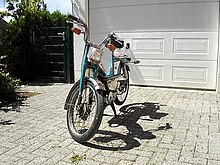Mobylette
Under the name Mobylette (falsely Mobilette ) was 1949-1984 by French bicycle manufacturer Motobécane a whole series of motor-assisted bicycles and mopeds prepared which have a characteristic drive via belts and chains. The frame was welded together from two stamped sheet metal halves, creating the cavity of the tank.
Drive concept
From the left-hand side of the engine crankshaft in the direction of travel , the power is transmitted via a centrifugally acting centrifugal clutch to a drive drum that is connected to a pulley. From this small pulley, a V- belt transmits the power to a clearly recognizable large pulley, which in turn runs with a disengageable pinion on the shaft of the pedals. A chain runs from the pinion to the rear sprocket. On the right side, there is also a chain from the sprocket of the pedals to the freewheel hub of the rear wheel.
Pedals are used to start the engine. In the event of a breakdown, the pinion can be mechanically separated from the large pulley using a rotary lever and it is possible to move the Mobylette via the pedals without the resistance of the centrifugal clutch.
Mobylette models with Moby-Matic also have a torque converter, which increases the drive diameter of the small pulley via an axially acting centrifugal control and thus varies the reduction ratio of the belt from 1: 18.7 to 1: 11.8. The force to return to the larger reduction ratio comes from the belt tension. This is generated by suspending the engine on the cylinder head so that it can pivot in the longitudinal direction and is pushed forward by means of a spring.
Types
While at the beginning of the 1960s the trend for mopeds in general was towards a more and more motorcycle-like character and the mokick , in France the Mobylette insisted on the original, more bicycle-like moped concept. The simple and very inexpensive design was very successful at the time, in 1960 alone more than 400,000 copies of the Mobylette were produced. The later Mobylette mopeds were also manufactured in numbers that were not even reached by Simson or Piaggio (up to 4500 mopeds per day). By 1973 alone, more than 9 million Mobylette had been built. The mopeds were most widespread in the 1970s, when they were mostly delivered in bright colors. Characteristic were light green, orange, yellow and medium blue. The vehicles were comfortably equipped with lots of chrome parts, indicators and rear-view mirrors, as well as some brake lights and indicators (N 150 LC).
The following mopeds up to 25 km / h are recorded:
- M-7 25 / 1.2 hp
- AV 142 / 0.5 PS
- AV 143 / 0.9 PS
- AV 144 / 0.9 PS
- M1 / 0.8 hp
- AV 146/1 PS
- 140 TL / 1 HP *
- N 140 TL / 1.5 PS
- N 150 L / 1.5 PS
- N 150 LC / 1.5 PS
Mopeds up to 40 km / h:
- AV 43 / 1.35 hp
- AV 44 / 1.35 hp
- AV 46 / 1.5 HP
- AV 59 / 1.5 PS (with Moby-Matic)
- AV 40 TL / 1.5 PS
- 50 VL / 1.5 PS
- 50 VL C / 1.9 PS (with Moby-Matic)
distribution
The sole agency for the Federal Republic of Germany and West Berlin was Mobylette Fahrzeughandelsgesellschaft mbH in Bielefeld .
Web links
Individual evidence
- ↑ French moped. In: Motor vehicle technology 1/1962, p. 21
- ↑ http://die-kleinkraftrad-ig.de/pdf/3904500mopedsamtag1973.pdf

